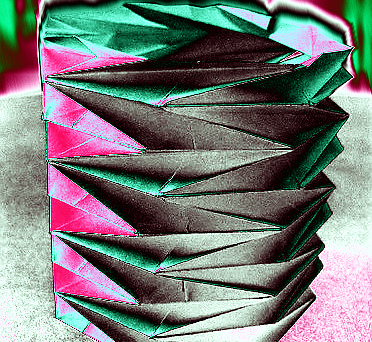Nano-pinwheel watched
 Scientists are hopeful about the potential of a newly-discovered pinwheel structure; self-assembled from pyramid-shaped nanoparticles.
Scientists are hopeful about the potential of a newly-discovered pinwheel structure; self-assembled from pyramid-shaped nanoparticles.
The ‘transformer’ pinwheels may enable unique material properties that could be useful in areas like machine vision, armour, chemical and biological sensing, and more.
A key quality of the nanomaterial is chirality, a kind of twist found throughout nature from DNA's double-helix to spiral galaxies.
Nature uses chirality to reliably engineer very complex and dynamic systems, including all living organisms.
Recreating these twisted structures on the nanoscale has not been easy.
Researchers have relied on templates that produced very small structures, limiting their usefulness in the design of nano-engineered materials, says Dr Qian Chen, professor of materials science and engineering.
The team decided to explore the possibilities of pyramid-shaped particles as building blocks, which had previously been shown to arrange themselves into patterns that could change depending on their environments.
“It is amazing to observe how tight the relationship between chirality and practicality is,” said researcher Dr Nicholas Kotov.
“As soon as the particle layer becomes chiral, it acquires new useful properties.”
The research team made the structures out of gold nanoparticles, enabling them to self-assemble while floating in a tiny droplet of a water-based solution that sat atop a silicon wafer. As the fluid dried, the pyramids self-assembled onto the flat surface.
If the particles have no electric charge, they form a honeycomb pattern that is not chiral, but electric charges make the tiny pyramids turn a little with respect to one another, twisting the honeycomb into a repeating pinwheel structure.
The resulting lattice is large enough to be seen with the naked eye, but the assembly of pyramids with 100-nanometer sides is not.
An electron microscope is needed to peer into the droplets. In fact, that feedback enabled the team to adjust the electric charge to get the pinwheel pattern.
The trouble is, the pinwheel pattern is not one continuous design - it is broken into smaller domains like neighbourhoods on a city map.
These were equally divided between a right-hand twist and a left-hand twist. Shine light through it, and it does not get the strong twist it would get if all the pinwheels pointed in the same direction. With domains 0.005 millimetres across, even a laser wasn't small enough to focus on a single one.
The team had to take their pinwheel samples to Argonne National Laboratory to be measured with a laser and an electron microscope.
The laser provided twisted light that was tightly focused on a few domains, and the domains that matched the twist were essentially lit up when viewed with an ultrafast electron microscope.
Future work on the structures will explore how to achieve lattices that twist in only one direction and then translate these chiral assemblies into a range of applications.
Dr Kotov suggests biosensors for viruses and “smart” adaptable catalysts that take advantage of the quick shift from the honeycomb to the pinwheel structure.
This dynamic reconfiguration could also be useful for machine vision such as LiDAR on self-driving cars, which relies on twisted light to achieve depth perception. The pinwheel lattices are also potentially useful in the design of combat helmets and aeroplanes, for example.
The study is accessible here.








 Print
Print